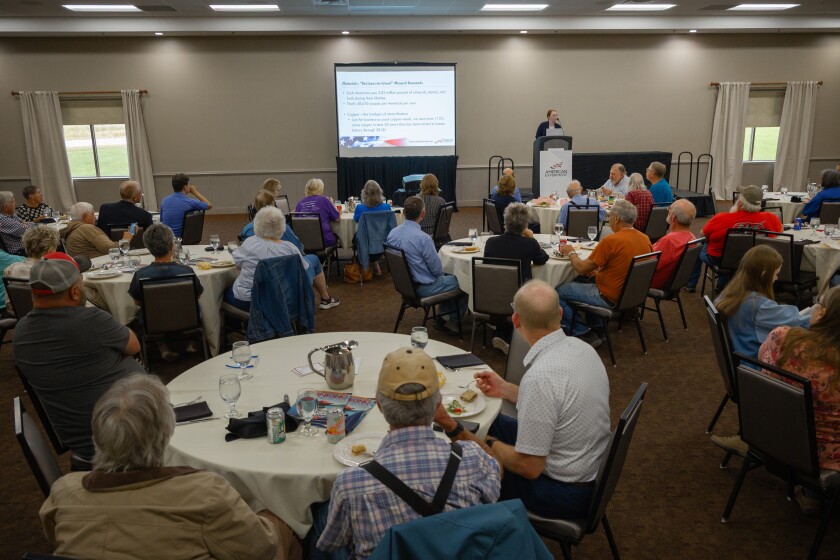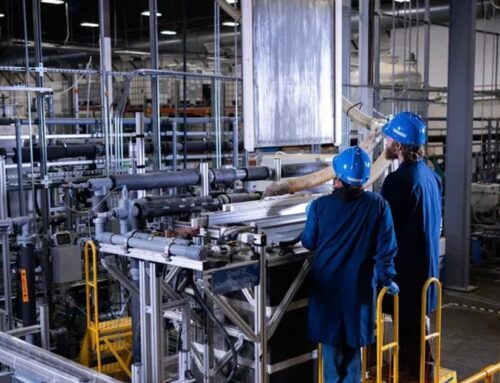Policy analyst: Renewable energy impacts require more study
October 1, 2025
ROCHESTER — Sarah Montalbano is raising questions about the environmental benefits in adopting renewable energy sources.
“I think there are a lot of misconceptions about the environmental friendliness of it,” the Center of the American Experiment energy policy fellow told a group of nearly 100 Rochester residents on Wednesday, Oct. 1.
With Minnesota setting a goal for 100% carbon-free electricity by 2040, and Rochester’s Public Utilities Board reaffirming its commitment to a 100% net renewable goal by 2030, Montalbano said such decisions require more study.
“We need to be honest about the tradeoffs,” she said, as she presented findings from
a report she produced for the conservative nonprofit.
She said a one-size-fits all answer doesn’t exist when it comes to energy production.
“Every form of energy generation has its challenges and benefits,” she said. “We have a lot of negative impacts of wind turbines, solar panels and battery storage that are often overlooked.”
She said the negative impacts range from destroying wildlife habitat to increased costs of recycling or disposing of decommissioned infrastructure.
When it comes to habitat concerns, Montalbano raised questions about whale deaths near offshore wind turbines and inland raptor deaths. She said some cases lack sufficient study to draw solid conclusions, but the uncertainty points to the need for more research.
“We want to make sure we are living well among the organisms in our environment,” she said.
Wednesday’s presentation came a day after Rochester’s Public Utilities Board
reviewed customer survey results
showing 70.6% of participants support the city’s transition to renewable energy, which includes approval of a recent wind-energy agreement, as well as
two more being considered Monday.
Rochester Public General Manager Tim McCollough said he was invited to Wednesday’s event, but declined the offer. He also declined to comment on Montalbano’s report, but said Rochester’s effort to achieve its 2030 goal remains flexible as the city-owned utility seeks to replace electric supplies currently purchased from Southern Minnesota Municipal Power Agency.
While added solar infrastructure has been ruled out in the near term, due to cost inefficiencies, he said city staff will continue to study options to add energy resources by 2034, when more electricity production is likely to be needed to meet customer demand.
Montalbano said the state and cities shouldn’t rule out options that already provide reliable and affordable energy.
“We at American Experiment have really been on the cusp of advocating for affordable, reliable electricity, like nuclear, natural gas, oil and coal,” she added. “The positives of those things are being overlooked.”
She said traditional resources also entail more efficient land use. She said at least 10 times the land is needed to provide wind and solar power, when compared to plants powered by coal or natural gas.

Joe Ahlquist / Post Bulletin
“You don’t need nearly as much land to generate power with these technologies,” she said.
She also raised questions about the materials needed to build wind and solar infrastructure, pointing to a growing reliance on materials that are mined in other countries.
She pointed to estimates in a 2023 Energy Transitions Commission report, indicating that would create an annual demand for 20 million metric tons of copper through 2050 to meet global net-zero demands.
“The U.S. only produced about 1 million metric tons last year,” she said, adding that worldwide production was 23 million metric tons.
“Net zero would need 87% of the world’s primary copper supply every year,” she said. “That, of course, isn’t feasible, because we need copper for lots of different things.”
Additionally, she said mining practices in other countries lack environmental and human rights oversight seen in the United States, pointing to child labor used in the Democratic Republic of the Congo.
“That is not what I want to be sponsoring by my choices,” Montalbano said.
“The U.S. is making a value judgment every time we decide we’d rather offshore a mining project, rather than do it here in the United States under our responsible standards for the environment and for workers,” she added.
She said such concerns need added study to ensure state and federal policies don’t cause shifts to renewable energy that have negative impacts elsewhere.
“We are not saying wind and solar are bad because they have an impact on the environment,” she said. “All human activities have an impact on the environment.”
She questioned whether all long-term impacts are being considered, noting the lifespan of energy sources can vary, from 20 years for wind turbines to up to 80 years for nuclear plants.
“We are replacing these things four times and three times as often as natural gas or coal,” she said of wind and solar infrastructure, suggesting federal tax credits have led to more frequent replacements in an effort to repeatedly capture the 10-year benefits.
With added state goals, she said it’s understandable that more electricity providers are making the shift.
“Utilities are kind of put in a bind,” she said. “They have to comply with state law.”
Search
RECENT PRESS RELEASES
Related Post




